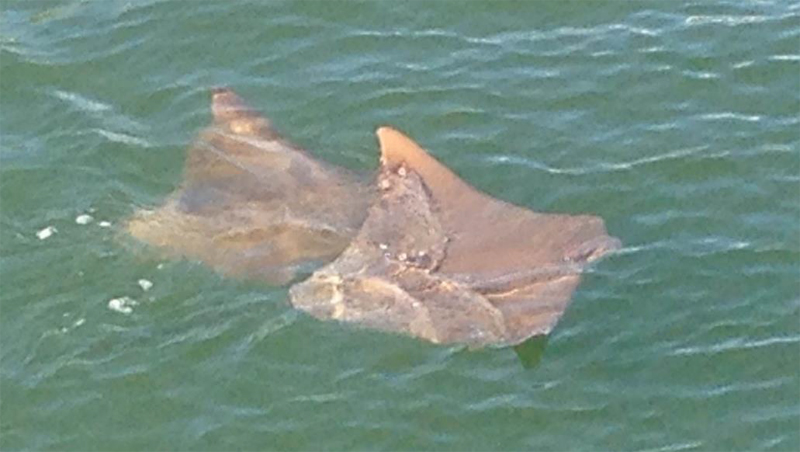New Addition To Bermuda’s Marine Wildlife
In a recent edition of the Envirotalk newsletter, Dr. Mark Outerbridge highlights the cownose ray.
Dr. Outerbridge said, “Until recently, Bermuda had two species of resident rays; the spotted eagle ray Aetobatus narinari [locally known as the whip moray], which is typically encountered inshore, and the much larger manta ray Manta birostris, which lives in the open ocean. However, in the spring of 2015, a member of the public reported seeing a number of unusual looking rays in Mill’s Creek.
“They were not spotted eagle rays but rather something smaller and lacking the white dorsal spots. Another member of the public subsequently managed to photograph two individuals on the surface of Mill’s Creek, at which point the Department of Environment and Natural Resources [DENR] was able to positively identify them as cownose rays Rhinoptera bonasus.
Two cownose rays photographed in Mill’s Creek [photo courtesy of Matthew Jones]:
“Cownose rays belong to a group of fishes that includes the eagle rays and the manta rays. They have a broad, lumpy head which, when viewed from above, somewhat resembles the nose of a cow. They are typically a uniform brown or olive green in colouration with a pale belly. They have barbed spines where the long thin tail meets the body, and these spines are capable of delivering a ‘sting’ if the ray feels threatened.
“Adult females normally attain a wing-span of about three feet and weigh up to 50 pounds [versus spotted eagle rays, which are twice that size and at least three times the weight]. Sexual maturity is reached at the age of 4-5 years. Females normally produce only one pup at a time, and the pup is born live with a wingspan of 11-18 inches.
“Cownose rays are native to the western Atlantic Basin and usually live in shallow marine coastal waters. They are known to swim in large schools [sometimes numbering thousands of individuals] and migrate long distances throughout their range. A migratory school originating from the eastern seaboard of the USA likely took a wrong turn somewhere and ended up bumping into Bermuda.
“Anecdotal evidence suggests that it was a small school that arrived in 2014 or 2015. It appears that the founding rays decided to remain here rather than take the risk of returning the way they came. By May 2016, there were rumours of 25-30 individuals being seen within the Great Sound, and in November of that year, a cownose ray was seen attempting to swim against the tidal current of Flatt’s Inlet into Harrington Sound.
“Cownose rays are fond of eating clams, oysters, and large marine snails. In some areas of the USA, large populations of cownose rays are thought to have contributed to the decimation of local shellfish populations [e.g. bay scallops and oyster beds].
“Some fisheries scientists believe that this may have happened because of the significant decline in shark populations. Decades of fishing has led to an alarming depletion of shark species worldwide. Sharks prey on rays and thus control their number and influence behaviour [such as foraging]. The loss of the sharks has enabled some ray populations to grow in size and feed in an unregulated manner.
“The very same dynamic may be happening locally with green sea turtles and our declining seagrass meadows [see the autumn 2020 edition of Envirotalk Vol. 84 No. 3].
“It looks as if the cownose rays are here to stay. Residents are sighting them more and more, and DENR has received at least one report of a birthing event, so it is expected that the local sub-population will grow over time in abundance and distribution.
“It remains to be seen how this new species of inshore ray will affect Bermuda’s mussels, oysters, calico clams, and conch. One thing is certain, the local scarcity of sharks will give the cownose rays a good chance to become firmly established here.
“For those of you who have not yet seen a cownose ray, the Bermuda Aquarium Museum and Zoo acquired a young female this past March and has put her on display in the North Rock Tank, where I hear she is doing well.”
Read More About
Category: All, Environment, News




It’s an invasive species, eradicate it from our waters. If the cownose gets into Harrington Sound what will it do to the calico???
There are no calicos so stop talking about them okay. This story is not true what we have here are spotted eagle rays that have been in Mills Creek too long and have mutated like the famous turtles. Sub species ninja bermudensis.